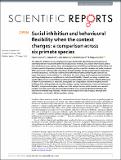Social inhibition and behavioural flexibility when the context changes : a comparison across six primate species
Date
15/02/2018Metadata
Show full item recordAbstract
The ability to inhibit previously employed strategies and flexibly adjust behavioural responses to external conditions may be critical for individual survival. However, it is unclear which factors predict their distribution across species. Here, we investigated social inhibition and behavioural flexibility in six primate species (chimpanzees, bonobos, orangutans, gorillas, capuchin monkeys and spider monkeys) differing in terms of phylogenetic relatedness, foraging ecology and social organization. Depending on the social context, individuals could maximize their food intake by inhibiting the selection of a larger food reward in one condition (i.e. inhibition), but not in others, which required them to flexibly switching strategies across conditions (i.e. behavioural flexibility). Overall, our study revealed inter-specific differences in social inhibition and behavioural flexibility, which partially reflected differences in fission-fusion dynamics. In particular, orangutans and chimpanzees showed the highest level of inhibitory skills, while gorillas and capuchin monkeys showed the lowest one. In terms of behavioural flexibility, orangutans and spider monkeys were the best performers, while bonobos and capuchin monkeys were the worst ones. These results contribute to our understanding that inhibition and behavioural flexibility may be linked in more complex ways than usually thought, although both abilities play a crucial role in efficient problem solving.
Citation
Amici , F , Call , J , Watzek , J , Brosnan , S & Aureli , F 2018 , ' Social inhibition and behavioural flexibility when the context changes : a comparison across six primate species ' , Scientific Reports , vol. 8 , 3067 . https://doi.org/10.1038/s41598-018-21496-6
Publication
Scientific Reports
Status
Peer reviewed
ISSN
2045-2322Type
Journal article
Description
This work was conducted while the first author held a Humboldt Research Fellowship for Postdoctoral Researchers (Humboldt ID number 1138999). We acknowledge support from the German Research Foundation (DFG) and Leipzig University within the program of Open Access Publishing.Collections
Items in the St Andrews Research Repository are protected by copyright, with all rights reserved, unless otherwise indicated.

